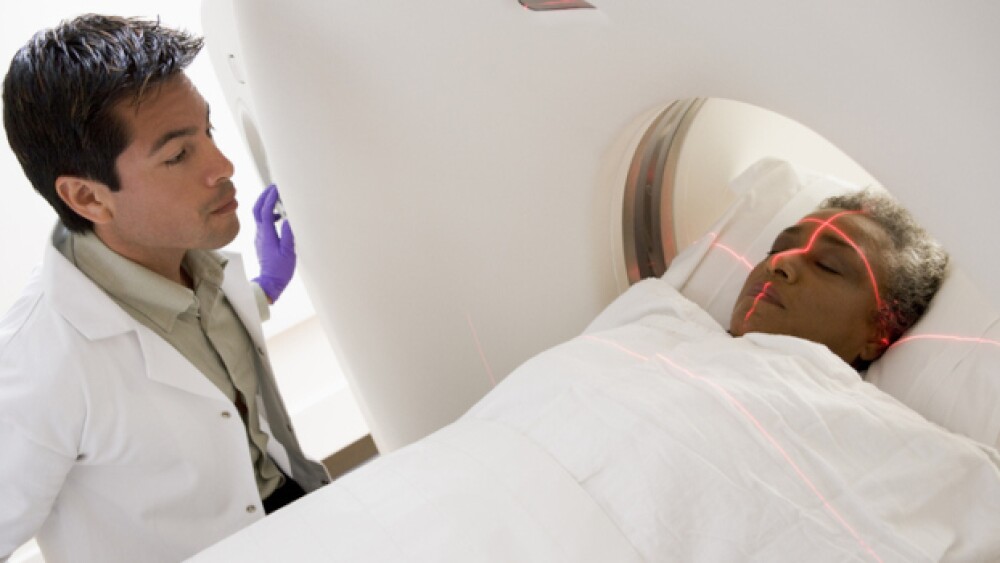Fueled partly by increasing lifespans and cancer incidence, the area’s worth is projected to soar to 13.67 billion by 2032, Precedence Research reports.
Pictured: A doctor watches as a patient goes into a CT scanner/iStock, monkeybusinessimages
Venture capital investment in radiopharmaceuticals increased $63 million in 2017 to $408 million in 2023, according to a new GlobalData report. Annual venture funding in the sector peaked at $262 million in 2021, GlobalData said, all of which was in the preclinical and discovery stages of development.
Separately, ARTBIO announced on Thursday that it has raised $90 million in Series A financing for its programs developing a new class of targeted alpha radioligand therapies.
Original story posted December 6:
Advancements in science, aging populations and increased cancer incidence are expanding the size of the radiopharmaceutical market. Analysts at Precedence Research report that the market, which swelled from about $3.9 billion in 2017 to $5.2 billion in 2022, is growing at a compound annual growth rate of 10.2% and will surpass $13.67 billion by 2032.
“Using radioisotopes is relatively new . . . but I’ve never seen this sort of excitement around a new form of cancer care,” said Mark Crockett, chief medical officer at Mirada Medical, which develops imaging software for nuclear medicine. “There is a lot of investment of time, effort, money, and a lot of new therapies on the horizon. It is wildly exciting,” he added.
Radiopharmaceuticals are radioactive agents used in diagnosing or treating diseases. There are more than 50 radiopharmaceutical drugs on the market, and many more are in clinical trials. Many of these drugs are designed to treat cancers.
A Strong Player in Cancer
One leading radiotherapeutic is Pluvicto, which the FDA approved last year for the treatment of prostate cancer. “There is expected to be an increase in [radiopharmaceutical] sales in the coming years largely driven by Novartis’ Pluvicto, which is expected to be a blockbuster drug that will drive sales by itself by nearly four billion dollars by 2029,” said Quentin Horgan, associate director of drug intelligence at GlobalData.
Analysts at Precedence Research credit the expanding market to increased government funding; however, Frank Scholz, CEO of Northstar Medical Radioisotopes, said he sees the momentum in the industry as being privately driven. Rising geriatric populations and cancer incidences are also factors in radiopharmaceuticals’ growth, according to Precedence Research. The 2023 World Social Report published by the United Nations shows that there are more than 700 million people in the world aged 65 and above, and this number is predicted to rise to about 1.6 billion in 2050.
A long lifespan increases one’s chances of developing diseases like cancer, Crockett noted. “I think globally, we’ve seen an increase in lifespan, so that puts us in a position where we’re going to have to deal with cancer more often, and maybe even cancers that we’re not used to seeing,” he explained.
Radiopharmaceuticals are exceptional in that they enable many cancer patients to enjoy a number of years with a high quality of life, Crockett said. Radiopharmaceuticals have proven to effectively treat cancers when other options fail.
“I think it’s all about patient outcome,” Scholz said. “I think this will be another leg on the stool for cancer treatment.”
Growth Factors
While cancer applications accounted for more than 53% of radiopharmaceutical revenue in 2022, according to Precedence Research, the cardiology segment is predicted to have the fastest compound annual growth between 2023 and 2032. And while the diagnostic segment generated 65% of the industry’s revenue in 2022, the therapeutic segment is projected to grow at the fastest compound annual growth rate over the next ten years.
In Horgan’s view, a key reason for the market’s overall growth is that many of the newest drugs are antibody-drug conjugates, which are expensive. “That is probably driving the sales rather than increased demand per se,” he said.
Crockett disagreed, instead attributing the rapid market growth to scientific advancement. He said the market is growing because radiopharmaceuticals are providing effective options for diseases that had fewer treatments in the past. For instance, some therapies target previously difficult-to-treat neuroendocrine tumors with what is known as an antibody radioactive cocktail. One such drug is Novartis’ Lutathera, which was approved in 2018 to treat a rare form of neuroendocrine cancer in adult patients. “When you do something like this, you are creating a brand new therapeutic for a class of patients with a particular type of cancer and that opens up a new market for those patients,” Crockett said. In 2020, Lutathera garnered sales of about $445 million.
Scholz noted that even though the industry is experiencing tremendous market growth, the momentum varies by continent. The Asia-Pacific region is poised to grow at the highest CAGR owing to its large and aging population. Analysts at Precedence Reserch report that North America generated 44% of the industry’s 2022 revenue, driven by a large population of chronically ill patients, a concentration of top radiopharmaceutical companies and a robust healthcare system.
By contrast, Crockett said poor infrastructural development curtails the industry’s growth in many parts of the world. He said many countries lack radiodiagnostic tools, and this limits the use of these drugs. A 2021 study shows that many areas, especially low- and middle-income countries, still lack equipment, such as the molybdenum-technetium generator system that is needed for imaging systems. This is largely due to the irregular supply of these products.
“Scanners are not well distributed, which makes it a unique challenge to give these medications,” Crockett said. He said there will be radiopharmaceuticals growth in countries where there are scanners and trained physicians.
“North America is one continent where there is lots of activity, and Europe when you think about clinical work,” Scholz said. But he expects that in coming years more companies will emerge on other continents, and new talent will flow into the industry, driving growth. “Europe and North America have been the starting continents, but [growth in the radiopharmaceutical industry] will not be restricted to that,” he added.
Patience Asanga is a Nigeria-based freelance science journalist who writes about the environment, biotechnology and life sciences.






